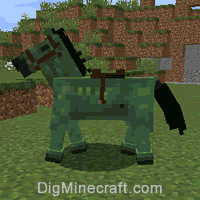NBT Tags for Zombie Horse in Minecraft (Java Edition 1.16/1.17/1.18/1.19/1.20)
This Minecraft tutorial explains the NBT tags (formerly called data tags) that you can use for a zombie horse in Minecraft Java Edition (PC/Mac) 1.16, 1.17, 1.18, 1.19 and 1.20.
TIP: If you are not running Minecraft Java Edition (PC/Mac) 1.16/1.17/1.18/1.19/1.20, find NBT tags for zombie horse in another version of Minecraft:
(If you are running Minecraft Java Edition (PC/Mac) 1.10 or older, use the EntityHorse data tags for a zombie horse)
Background
In Minecraft Java Edition 1.16, 1.17, 1.18, 1.19 and 1.20, the entity value for a zombie horse is zombie_horse. The zombie_horse entity has a unique set of data tags that can be used in Minecraft commands such as: /summon and /data.

What are NBT tags (formerly called Data Tags)?
NBT tags allow you to set certain properties of an entity (such as zombie_horse). The NBT tag is always surrounded in {} such as {Tame:1}. If there is more than one NBT tag used in a game command, the NBT tags are separated by a comma such as {Tame:1, CustomName:"\"George\""}.
List of NBT Tags
Here is a list of the NBT tags that you can use for zombie_horse in Minecraft Java Edition (PC/Mac) 1.16, 1.17, 1.18, 1.19 and 1.20:
| NBT Tag | Value (Description) | Works With |
|---|---|---|
| Tame | 0 (The zombie horse is wild) Example |
/summon /data |
| SaddleItem | If the zombie horse is wearing a saddle, it is used to specify the Minecraft id for the saddle and number of saddles worn by the zombie horse Example |
/summon /data |
| Temper | number (The temper of the zombie horse which is a number from 0 to 100. The higher the number, the easier it is to tame the zombie horse.) Example |
/summon /data |
| InLove | ticks (The number of game ticks that the zombie horse is in love mode and will try to breed with another zombie horse) Example |
/summon /data |
| Bred | 0 (The zombie horse has not bred) Example |
/summon /data |
| Age | ticks (The age of the zombie horse in game ticks. Use 0 or higher for an adult. Use a negative number such as -25000 for a baby.) Example |
/summon /data |
| ForcedAge | ticks (When a baby zombie horse matures, the Age data tag will be set to ForcedAged. However, there have been bugs with this data tag so it may not work properly.) Example |
/summon /data |
| EatingHaystack | 0 (The zombie horse is standing normally) Example |
/summon /data |
| Leash | Indicates the coordinates of the fence that the zombie horse is leashed to. Example |
/summon /data |
| CustomName | name (The name to assign to the zombie horse) Example |
/summon /data |
| Health | number (The number of health points the zombie horse has) Example |
/summon /data |
| AbsorptionAmount | number (The number of absorption health points the zombie horse has) Example |
/summon /data |
| Invulnerable | 0 (The zombie horse will take damage like normal) Example |
/summon /data |
| PersistenceRequired | 0 (The zombie horse will despawn naturally) Example |
/summon /data |
| NoAI | 0 (The zombie horse will have artificial intelligence and will move/behave like normal) Example |
/summon /data |
| Silent | 0 (The zombie horse will make its usual noises in the game) Example |
/summon /data |
| Fire | ticks (The number of game ticks until the zombie horse is no longer on fire - there are 20 ticks in a second) Example |
/summon /data |
| PortalCooldown | ticks (The number of game ticks until the zombie horse can go through a portal again - there are 20 ticks in a second) Example |
/summon /data |
| Air | ticks (The number of game ticks the zombie horse has air left for) Example |
/summon /data |
| id | zombie_horse (The entity value used to represent a zombie horse in the EntityTag or Passengers tag) Example |
/summon /give |
| Passengers | The mob that is riding on the zombie horse. Use the entity value for the passenger mob Example of skeleton as passenger |
/summon /data |
NBT Tag Examples
To summon a baby zombie horse:
/summon zombie_horse ~ ~ ~ {Age:-25000}
To summon a tame zombie horse wearing a saddle:
/summon zombie_horse ~ ~ ~ {Tame:1, SaddleItem:{id:saddle,Count:1}}
Target Selectors
Before we finish discussing data tags, let's quickly explore how to use the @e target selector. The @e target selector allows you to target entities in your commands. If you use the type=zombie_horse value, you can target zombie horses:
@e[type=zombie_horse]
Target Selector Examples
To change the nearest zombie horse to a baby zombie horse:
/data merge entity @e[type=zombie_horse,limit=1,sort=nearest] {Age:-25000}
To kill all zombie horses:
/kill @e[type=zombie_horse]
Next, learn how to use the game commands in Minecraft.
Command Examples
Here are some game command examples for a zombie horse in Minecraft:
Command Generators
If you need help, you can use these tools to automatically generate commands for you:
Advertisements





